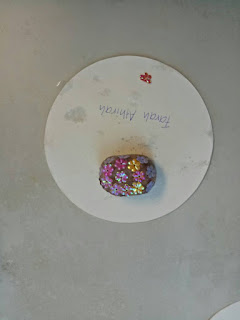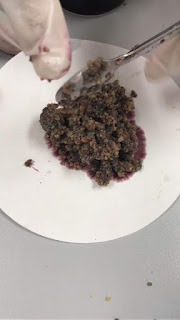DEPARTMENT
OF BIOLOGY
FACULTY
OF SCIENCE & MATHEMATICS
UNIVERSITI
PENDIDIKAN SULTAN IDRIS
SBK3013
PRINCIPLE
IN BIOCHEMISTRY
LABORATORY PROJECT 4
APPLICATION: MAKING SOAP
NAME
|
MATRIC NO.
|
MUHAMMAD FARIS BIN ISMAIL SAZEMI
|
D20141067089
|
MAYURIE PHUTHARANT A/P SURIN
|
D20141067078
|
NUR AFIQAH SYAHMINA BT MOHD KAMAL
|
D20141067091
|
GROUP: A
LECTURER’S NAME: DR. ROSMILAH MISNAN
INSTRUCTOR NAME: NUR ATIEKAH BT AZAHARI
INTRODUCTION
The
ancients Egyptian around 1550 BC combined both animal and vegetable oils with
alkaline salts to produce a soap-like substance. They used this mixture for
treating sores, skin diseases as well as washing. Nowadays soaps are known as
carboxylate salts with a very long hydrocarbon chains. Soap can be made from the
base hydrolysis of a fat or oil. This process is called saponification, and the
reaction has been known for centuries. Traditionally, soaps were made from
animal fat and sodium hydroxide. Nowadays, soap can be made from different kind
of oil and fats. Addition of fragrance and colour into the soap has produce
varieties of soap. In this experiment,
we will be using different kind of oils and fat in order to make soap.
MATERIAL
60 ml of 6 M NaOH solution
17.5 g of fat (sunflower oil, corn oil, palm oil, margarine, butter)
75 ml distilled water
300 ml hot sodium chloride (NaCl) solution.
100 ml graduated cylinder
400 ml beaker
250 ml beaker
Stirring rod
Colour and fragrance
PROCEDURE
1.
40 ml of the 6 M NaOH and 17.5 g fat was
placed into 250 ml beaker.
2.
The solution was heated to boil over the
lowest flame that will sustain the boiling process. The mixture was stirred to
avoid spattering.
3.
The mixture was boiling and stirring for
20 minutes, or until the water in the mixture has been evaporated.
4.
The remaining 20 ml of NaOH was added into
the mixture and continues boiling the solution for 20 minutes or until most of
the water was boiled off. Cannot let the mixture to boil dry.
5.
Let the crude soap to cool and a waxy
solid should be form. Then 12.5 ml of distilled water and 50 ml of hot and
saturated NaCl solution was added into the mixture.
6.
The mixture was stirred and the lump was
breaking up using the stirring rod.
7.
The wash solution was decant by pouring it
through a wire screen, to help trap the small soap particles.
8.
The wash process was repeated twice. After
that, for the final washing the soap was been pressed between the two sheets of
paper towelling to expel as much water as possible.
RESULT
Substance
|
Soap
|
Sunflower oil
|
|
Corn oil
|
|
Palm oil
|
|
Margarine
|
|
Butter
|
DISCUSSION
Soaps
and detergent are essential to personal and public health. By using soap, it
can remove germs, dirt and other contaminants and it also help us to stay
healthy. It also make our surrounding more pleasant because by using soap, it
will remove bad odour from our body. Basically, soap are made from fats and
oils or their fatty acids. The fatty acids can be divided further into 2 groups
that is saturated and unsaturated fatty acids. The saturated fatty acid contain
only carbon-carbon single bonds meanwhile for the unsaturated fatty acids it
contain multiple bonds between the carbon-carbon atom. Examples for saturated
fatty acid is stearic acid and palmitic acid, meanwhile for the unsaturated
fatty acids, examples are oleic acid.
Process
that is involved in this soap-making is saponification. The process which the
triglycerides reacted with sodium or potassium hydroxide to produce glycerol
and fatty acid salt, ‘called soap’. When Sodium Hydroxide is used, a hard soap
will be produced, meanwhile, when the potassium hydroxide is used, the
resulting products is soft soap. Lipids that contain fatty acid ester linkages
can undergo hydrolysis. This reaction is catalysed by a strong acid or base.
Saponification is the alkaline hydrolysis of the fatty acid esters.
For
example, when there is a chemical reaction between any fat and sodium
hydroxide, it is called as saponification reaction. The chemical equation for
the saponification process are as follows:
Triglyceride
+ sodium hydroxide (or potassium hydroxide) → glycerol + 3 soap molecules
The
soap molecules has two parts that is hydrophilic head (polar part), and
hydrophobic tails (non-polar part). The hydrophobic tails has water repelling
properties meanwhile, the hydrophilic head has water loving properties.
There
are two types of soap namely hard soap, and soft soap. The sodium salt of long
chain fatty acid is known as hard soap. It is difficult to dissolve in water.
It is used as laundry soap. The potassium salt of long chain fatty acid is
known as soft soap, as it produces more lather. It is used as toilet soap and
shaving soap. Since soaps have free alkali ions, they are alkaline in nature.
Hence, the soap solutions are slippery to the touch.
QUESTION AND ANSWER
1. What is the relationship between
saponification and phase (liquid / solid) of a triglyceride?
Saponification
triglyceride is actually the reaction of triglycerides when they are turned
into soap. Soap is produced when triglycerides react with a base like sodium.
In technical terms, saponification involves base that is hydrolysis of
triglycerides, which are esters of fatty acids, to form the sodium salt of a
carboxylate. In addition to soap, such traditional saponification processes
produces glycerol. "Saponifiable substances" are those that can be converted
into soap. Depending on the nature of the alkali used in their production,
soaps have distinct properties. Sodium hydroxide (NaOH) gives "hard
soap", whereas, when potassium hydroxide (KOH) is used, a soft soap is
formed.
2. Why do triglycerides with longer
fatty acids have a lower saponification number than those with shorter fatty
acids?
The
triglycerides with longer fatty acid have lower saponification because the
amount of KOH needed to break down the hydrolysis process is higher since the
triglycerides have long chain of fatty acid. So, the titration shown the lower
amount of KOH that react with HCL. The KOH left is unreacted KOH from the
hydrolysis process.
3. Why is the difference in the molar
amount of HCl used to neutralize the control and the amount of HCl used to
neutralize the sample equivalent to the molar amount of KOH used to saponify
the test sample?
In
the control sample which is filled with KOH then titrated with the HCL, it will
need a relatively large amount of HCL to neutralize it’s to form salt and water
compare with the test sample. This is because, in the control, all of the HCL
is needed to neutralize the KOH. Meanwhile, in the control sample, some KOH is
used to hydrolyse the fatty acids while some is neutralized by HCl. Therefore,
more HCl is utilized in the blank test than in the sample test.
4. Why do soaps disperse grease?
Grease
are non-polar compounds, meanwhile water are polar molecules. The non-polar
compounds cannot dissolve in the polar compound. This means that, grease cannot
dissolve in the water if they are mixed. However, soap can mix with both water
and the grease. This is because, the soaps has two different end that is
hydrophilic head, and hydrophobic tails. The hydrophilic head (water-loving
part) will attract the water molecules. Meanwhile, the hydrophobic tails
(water-hating part) will attract to the grease. When greasy dirt is mixed with
the soapy water, the soap molecules will arrange themselves into tiny clusters
namely micelles. The hydrophilic head sticks to the water, forming the outer
surface of the micelles. The hydrophobic tails will bind to the grease and the
grease will trapped in the centre due to its nature that it cannot make contact
with the water. With the oil tucked safely in the centre, the micelle is
soluble in water. As the soapy water is rinsed away, the greasy dirt goes along
with it.
CONCLUSION
In
this experiment, we successfully produced soap by using the sunflower oil. Soap
is one of the product produced by undergo the saponification reaction between
sunflower oil and heated sodium hydroxide.
REFERENCES
Zumdahl, Steven S.
(2009). Chemical Principles (6th ed.).
New York: Houghton Mifflin Company
David, A. K. (2000). The science of soaps and detergents.
Retrieved on May 1st, 2017 from
http://www.chymist.com/Soap%20and%20detergent.pdf
Hill, J.W.; Petrucci,
R.H.; McCreary, T.W.; Perry, S.S. (2005). General
Chemistry (4th ed.). Upper Saddle River, New Jersey: Pearson Prentice Hall.
Fromm, H. J.& Hargrove, M. (2012). Essentials of Biochemistry. Pearson Education









No comments:
Post a Comment